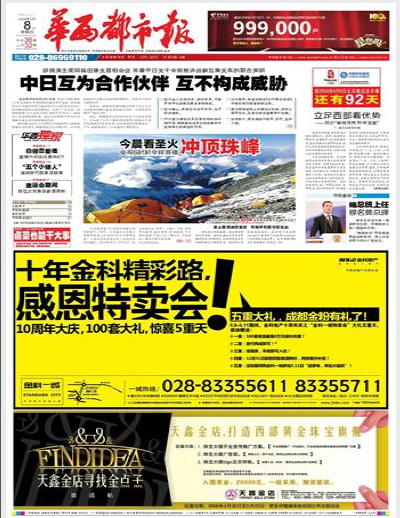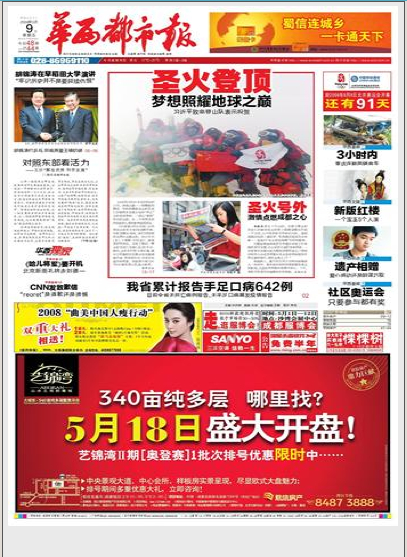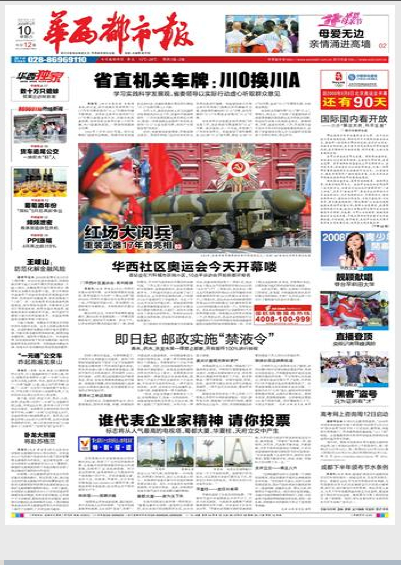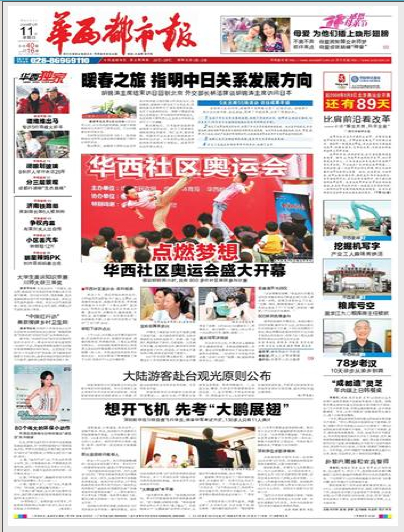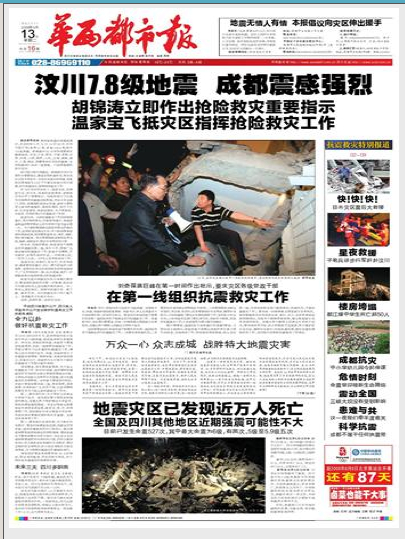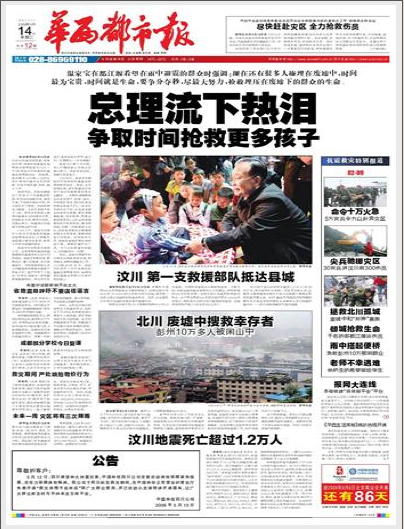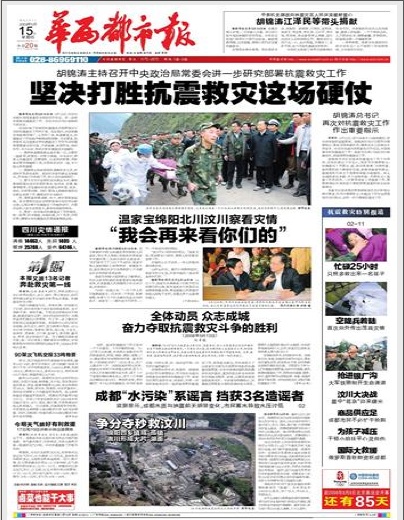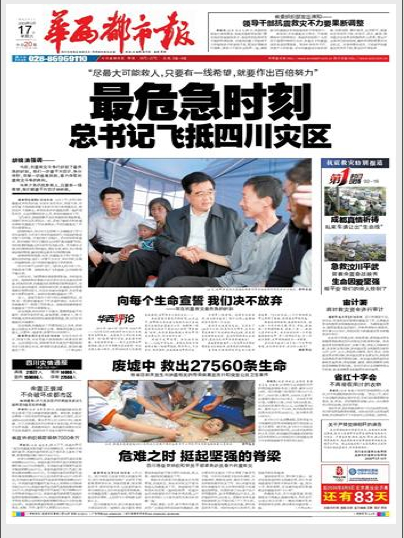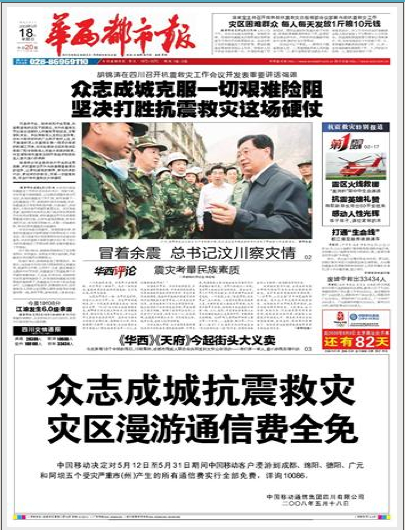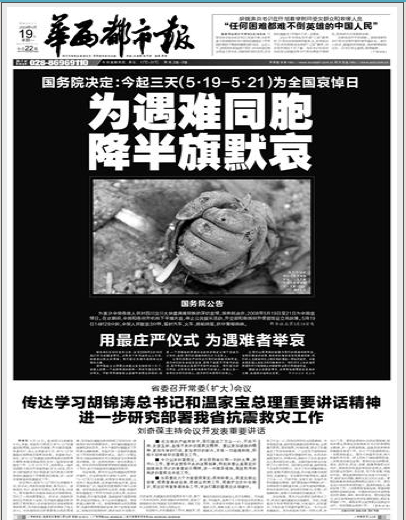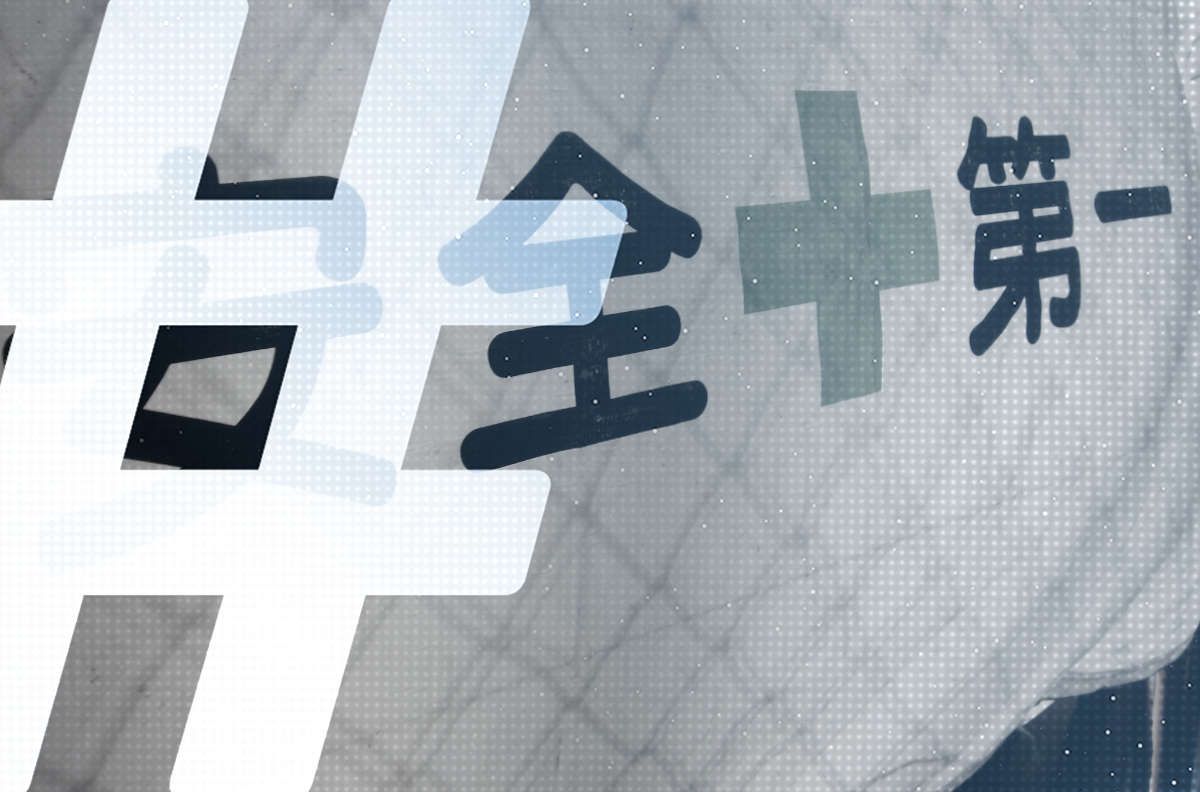Headlines and Hashtags
Facing crisis, one of Sichuan's top commercial tabloids returns briefly to its party-paper roots
By David Bandurski — On the morning of May 12, just hours before the disastrous magnitude 7.9 earthquake struck Sichuan, many readers in the provincial capital of Chengdu would have been poring through the latest edition of Huaxi Metropolis Daily (华西都市报), one of the region’s leading commercial newspapers (which, in fact, broke the Henan Aids epidemic story back in 1999). And the paper would have offered its characteristically dynamic look into city life, in marked contrast to its stiff and stodgy party counterpart, Sichuan Daily.
Sure, the main story that morning leaned a bit toward the party boilerplate — a Xinhua News Agency piece about China’s launch of its own domestic commercial jet manufacturer. Sure, there was an editorial off to the right from Sichuan Daily, blathering on about the party slogan “emancipation of minds” (思想大解放).
But there was plenty else to induce the discerning reader to pluck the paper off the newsstand.
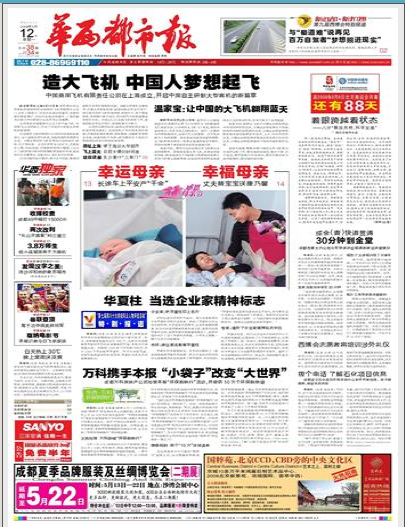
[ABOVE: Front page of the May 12 edition of Sichuan’s Huaxi Metropolis Daily.]
At center was a teaser for a juicy human interest story about a local woman who suddenly went into labor while she was in the car. There were two color photos to tug on the heartstrings, the first of the swaddled newborn, the second of happy new parents (a pair of Mother’s Day stories).
Tags pointed readers to other exciting content inside — coverage of the Cannes Film Festival, where the paper had posted a correspondent, analysis of China’s ping-pong hopes in the upcoming Olympic Games, and a story about a policeman in Chongqing who died of exhaustion at his desk.
Four days later, after the devastation wrought by the Wenchuan earthquake, Huaxi Metropolis Daily looked like a different newspaper altogether.

[ABOVE: Front page of the May 16 edition of Sichuan’s Huaxi Metropolis Daily.]
The difference was not merely that all of the front page news dealt with the earthquake and its impact on the area. That was understandable.
But in its layout the paper had made a sudden return to the habits of its party-paper ancestors. There was no longer any material difference with the layout of the wooden Sichuan Daily, save tiny advertisements for Sanyo and China Mobile, and the welcome respite of a right-hand sidebar.
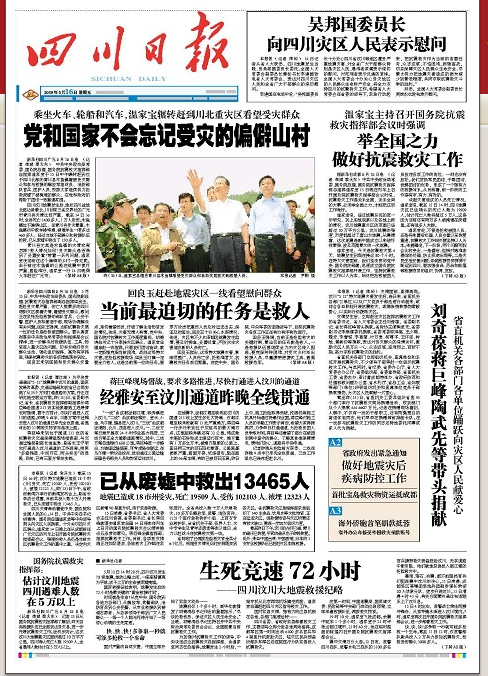
[ABOVE: Front page of the May 16 edition of Sichuan’s Sichuan Daily.]
There were other important changes too. The space just to the side of the newspaper’s masthead, generally a photo-accompanied teaser for reader-relevant inside coverage, had been scrapped for a Sichuan Daily release about how Sichuan Party Secretary Liu Qibao (刘奇葆) and vice-secretary Jiang Jufeng (蒋巨峰) had “taken the lead in contributing funds” for the relief effort.
All of the coverage on the front page of Huaxi Metropolis Daily was either from the official Xinhua News Agency or from the province’s party mouthpiece, Sichuan Daily.
The lead photograph — indeed, the only large photograph — was of top provincial officials, a clear throwback to the party-paper rule book.
This, of course, is not what we have come to expect from China’s new brand of commercial newspapers.
Since commercial newspapers emerged in China in the mid-to-late 1990s, their coverage has been increasingly distinct from that of the party newspapers, or dangbao (党报), which have persisted in the party news style, a stiff recounting of the actions and decisions of party and government leaders. While party papers have remained true to the media’s historic “mouthpiece” (喉舌) role under the CCP, commercial newspapers have, “propaganda discipline” notwithstanding, offered much more diverse content and a livelier look and feel.
Here’s the front page from the May 17 edition of Shanghai’s Oriental Morning Post, more of what we’ve come to expect from commercially-oriented papers.
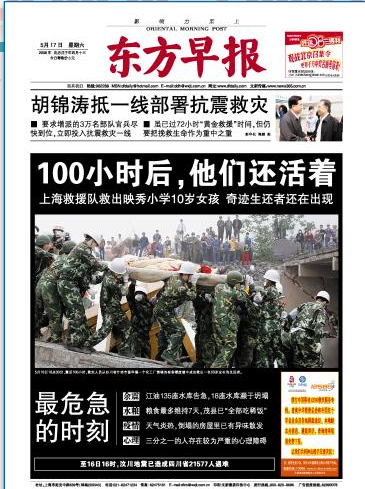
For a more thorough look at differences in coverage between party and commercial newspapers, we point readers to CMP’s 2006 case on the corruption scandal involving Beijing mayor Liu Zhihua.
It’s tough to say right now what the reasons are behind Huaxi Metropolis Daily‘s party-retro makeover, or why it seems to have occurred on May 16 (the previous three editions show the paper in reasonably commercial form).
While we know that China’s attitude in handling the disaster has so far been refreshingly open, it is conceivable — though this is purely speculation at this point — that Sichuan’s top party leaders have utilized (not necessarily with the worst of intentions, mind you) local commercial newspapers in order to take advantage of their vastly greater circulations.
Since the 1990s, the circulations of party newspapers throughout China have steadily dropped, and Sichuan’s officialSichuan Daily is no exception. This has presented something of a dilemma for party leaders hoping to get their own messages out to the public.
Of course, we do need to keep in mind that Huaxi Metropolis Daily has dispatched its own reporters to those areas most affected by the quake. An announcement in Friday’s edition, in fact, mentions that the paper has sent out an additional 13 reporters.
And today’s edition, which features an arresting black-and-white photograph of a child’s hand emerging from the rubble, seems to be a return to form for Huaxi Metropolis Daily, even as much of the front-page content remains Xinhua News Agency stuff.
Were the May 16-18 editions design hiccups? Nods to the provincial leadership? For now, we will leave the question open.
Meanwhile, we offer the following front-page images from Huaxi Metropolis Daily, in consecutive order from May 8 to May 19.
Readers may note that the space to the right of the masthead has been used consistently for content since the earthquake struck, a party-paper throwback. Content in this spot is as follows:
May 13 — a teaser from a report from Huaxi’s own reporter
May 14 — official news about top national leaders
May 15 — official news about top national leaders
May 16 — official news from Sichuan Daily about top Sichuan provincial leaders
May 17 — official notice from provincial leaders reported more or less verbatim by one of Huaxi‘s own reporters
May 18 — Xinhua News Agency release about top national leaders
